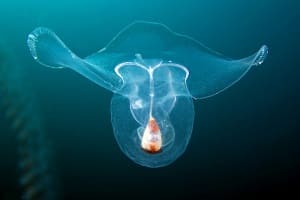Home › Sea Life › Marine › Spineless › Mollusks › Snails › Sea Butterfly
Interesting Facts about Sea Butterflies
[Thecosomata] [Phylum: Mollusca] [Class: Gastropoda] [Order: Pteropoda] [Family: Opisthobranchia]
Sea butterflies are a suborder of swimming marine snails that contain various specimens of slow-moving gastropod mollusks, including the 'shell-less' sea angels.
The facts and information in this guide highlight the vital role of the sea butterfly in our marine ecosystems and for the oceanic food chain.
Habitat and Distribution of the Sea Butterfly
You can find sea butterflies occupying almost all the deep water pelagic zones around the world.
Thus, they thrive best away from the shorelines of most warm and cold seawater environments, with several hot spots being:
- British Columbia
- California
- The North Atlantic Ocean
So, why are they called the 'sea butterfly' and how do they fulfil their pivotal role in the food chain? Simply put, the name comes from the way they use parapodia (wing-like lobes) for movement through the water - mirroring the land butterfly.
They are also known as the 'potato chips of the sea'. In fact, thecosamata species are an important food source for the majority of Arctic marine species, especially fishes, zooplankton, and seabirds.
Note: Even though the sea angel is a similar animal, there are notable differences in appearance. So for example, sea butterflies have a calcium carbonate case. Whereas, sea angels have a transparent, gelatinous body instead of the calcified shell.
Appearance, Diet, and Behaviour
Sea butterflies are Pteropod mollusks (free-swimming sea snails). They are a pelagic marine gastropod that also falls under the subclass of Opisthobranchia (phylum Mollusca).
One notable modification is a pair of winglike flaps (used in swimming). Despite being less than one centimetre in length (around 0.4 inches), they tend to live away from rocky coastlines. They spend most of their life near to the surface in open oceans.
 What Do Sea Butterflies Eat?
What Do Sea Butterflies Eat?
The sea butterfly is mainly passive in its feeding habits - with 'trapped' plankton being its primary source of food.
These tiny marine snails create a mucous net (around 5 centimetres in size) to capture any tiny plankton that floats into the web.
They will follow large blooms of planktonic animals by migrating deeper into the water column.
Even though sea butterflies spend a lot of time in warm surface water during the darkness at night, they will visit the deeper waters of the arctic and tropical oceans at dawn as the sun starts to rise.
Sea Butterfly Reproduction and Threats
Sea butterflies are hermaphroditic, meaning the young contain male and female reproductive organs. But, even though they start life as a male, they need to reach adulthood to start producing eggs. The reproductive process ends with the release of fertilised eggs into the water to hatch.
Marine Creatures Vulnerable to Ocean Acidification
Pteropods use mineral aragonite to form their shell. Thus, the effects of ocean acidification (changes to PH) can hinder the normal processes for building their protective armour.
Human activities cause significant changes to their natural habitat. As a result, acidic increases have now become the biggest threat to the existence of sea butterflies. They also need to watch out for predatory seabirds when they swim close to the water's surface.
Several large predators, such as whales and fish, consume copious amounts of sea butterflies. In fact, many large animals would struggle to survive without an abundance of these tiny organisms.
Related Information and Help Guides
- Australian Trumpet Shell Fun Facts and Information
- Slipper Shell Snail Facts: Information about Genus Crepidula
- Cone Snail: Interesting Facts for Beginners
- How Does Countershading Help Blue Dragons?
- Sea Snails Facts and Species Information
Note: The short video [3:51 seconds] has some additional facts about sea butterfly and sea angel species and how these winged gastropods 'fly' underwater, eat, and breed.